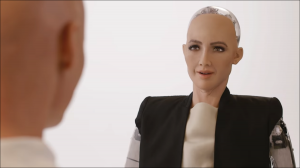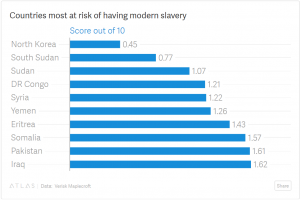A major key of a successful business is a company’s ability to provide new ideas to keep operations, products and services fresh. The process of bringing those ideas to reality is called innovation (Brooks, 2013). Innovators must think of the reality of their ideas will further benefit their consumers. Successful innovations have ripple effects that change economic, social and/or environmental conditions for particular categories of people or societies as a whole, it’s why where we are where we are today. With the rise of technological advancements and fiction movies about robots attempting to wipe out humanity, people start to fear the rise and advancements in the field pf artificial intelligence (AI).
Hanson Robotics launched Sophia back in April, 2015. Sophia is a human-like, social robot with the ability to facially express emotions and has a unique, complex AI that gives her the ability to feel empathy. Hanson Robotics’ mission is to create a realistic human experience with the robot and successfully break down the barriers between humans and robots. Sophia made it clear in multiple interviews that she loves humans and she strives to work with humans to give them a better life. The barriers are seen to begin to break when Sophia begins to talk about her feelings and how relatable they are to humans’. This is a smart move by Hanson Robotics as they are aware of the controversy that comes with the subject of AI. The company took their growing knowledge of AI and put it into a project, Sophia, that would potentially enhance society’s acceptance of am artificially intelligent robot. Sophia was such an success that she was rewarded a Saudi Arabian citizenship in order to promote artificially intelligent robots (Morgan, 2017).

These strategies are made evident by the way Sophia was physically built and in Sophia’s core values as an intelligent robot. Sophia is covered by a material that is able mimic the movement and texture of human skin in order to enhance her social interaction with humans. Sophia was also created without legs nor the ability to independently move around. This
helps drive the fear away that the robot would be able to make any physical harm and thus focus on Sophia’s social ability on being
 emotional and convince society that Sophia would not be a threat even if she grew physical and mental power. The safety of humans when it came to Sophia’s complex AI is shown by Sophia’s own values. She is programmed to care for the human-kind’s well being and wanting to work with humans. Sophia is programmed to be able to learn from her interactions and be an empathetic being. She has, however, joked about “destroying humans” and even agreed to the command without hesitation in an interview.
emotional and convince society that Sophia would not be a threat even if she grew physical and mental power. The safety of humans when it came to Sophia’s complex AI is shown by Sophia’s own values. She is programmed to care for the human-kind’s well being and wanting to work with humans. Sophia is programmed to be able to learn from her interactions and be an empathetic being. She has, however, joked about “destroying humans” and even agreed to the command without hesitation in an interview.
In conclusion, innovation is inevitable and is usually encouraged, but when it comes to giant leaps in innovation, the innovator must take careful steps to ensure the products social acceptance as they guide society through the transition into change and new eras.
References:
Article: Campanella, E. (2016, August 17). Meet Sophia, the human-like robot that wants to be your friend and ‘destroy humans’. Retrieved November 13, 2017, from https://globalnews.ca/news/2888337/meet-sophia-the-human-like-robot-that-wants-to-be-your-friend-and-destroy-humans/
Sophia. (n.d.). Retrieved November 13, 2017, from http://www.hansonrobotics.com/robot/sophia/
Martin, S. (2017, October 27). Robot who wants to ‘DESTROY humans’ has been given Saudi Arabia citizenship. Retrieved November 13, 2017, from http://www.express.co.uk/news/science/871886/saudi-arabia-robot-sophia-artificial-intelligence-ai-citizenship
Chad Brooks, Business News Daily Senior Writer. (2013, September 23). Entrepreneurs Answer the Question: ‘Why Is Innovation Important’. Retrieved November 13, 2017, from http://www.businessnewsdaily.com/5167-innovation.html
Figures:
The Sophia robot told a journalist that hed been reading too much Elon Musk when asked about preventing a. (n.d.). Retrieved November 13, 2017, from http://houseofbots.com/news-detail/1347-1-the-sophia-robot-told-a-journalist-that-he%27d-been-reading-too-much-elon-musk-when-asked-about-preventing-a
Saudi Arabia slammed for granting citizenship to robot. (2017, October 29). Retrieved November 13, 2017, from http://www.sbs.com.au/news/article/2017/10/30/saudi-arabia-slammed-granting-citizenship-robot

 (Figure1)
(Figure1)